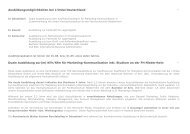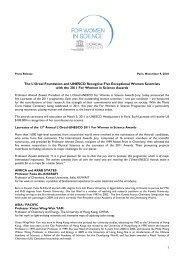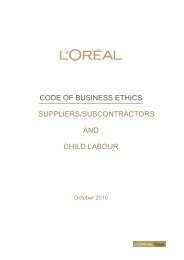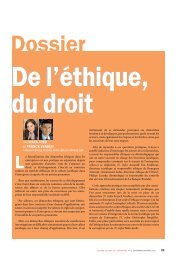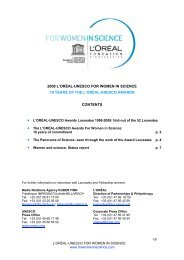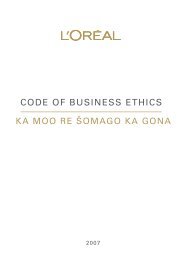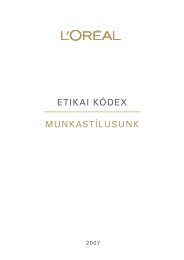2011 EDITION
2011 EDITION
2011 EDITION
Create successful ePaper yourself
Turn your PDF publications into a flip-book with our unique Google optimized e-Paper software.
For her work on light-emitting<br />
materials and innovative ways<br />
of capturing solar energy<br />
In recent years, chemists have also focused their research<br />
on physio-chemical transformations triggered by light to<br />
better understand this phenomenon and to take advantage<br />
of light-molecule interactions. The idea is to design electronic<br />
“communication” pathways by constructing nanometric<br />
complexes using organic molecules, which when brought into<br />
the presence of metal atoms, assemble themselves into organometallic<br />
molecular structures.<br />
In molecular electronics, Professor Yam has also tested the<br />
capacity of organic and organometallic systems to transfer or<br />
process information. Her work shows that these molecules<br />
can serve as molecular junctions because they act like electric<br />
wires.<br />
From Oil Spills to Medicine<br />
The photoactive materials developed by Professor Yam have<br />
far more applications than just solar energy. Many technologies<br />
we use daily rely on photoactive materials, such as<br />
organic light-emitting diode displays (OLED). The discovery<br />
and development of materials for efficient white organic lightemitting<br />
diodes (WOLEDs) will also have a huge impact to<br />
meet the challenge towards the launching of a more efficient<br />
solid-state lighting system as lighting currently takes up about<br />
19 % of the global power. Yet, biology is probably one of its<br />
most spectacular fields of application. By emitting light when<br />
exposed to oil or heavy metal ions, for example, these materials<br />
could be used to detect environmental hazards such as<br />
an oil spill or radioactive contamination. In healthcare, photoactive<br />
materials could also serve as chemosensors, detecting<br />
glucose in the blood of diabetics or the presence of malignant<br />
cells.<br />
The Youngest Member of the<br />
Chinese Academy of Sciences<br />
Professor Yam received her bachelor’s and PhD degrees from<br />
the University of Hong Kong. She taught at City Polytechnic<br />
of Hong Kong before joining the University of Hong Kong as<br />
a faculty member. She has served as the Chair Professor of<br />
Chemistry since 1999 and headed the chemistry department<br />
for the two terms from 2000 to 2005.<br />
At age 38, she was the youngest member ever elected to the<br />
Chinese Academy of Sciences. She is also a Fellow of TWAS,<br />
the Academy of Sciences for the Developing World, and<br />
was awarded the State Natural Science Award and the RSC<br />
Centenary Medal.<br />
VIVIAN WINg-<br />
WAH YAM<br />
IN HER OWN<br />
WORDS<br />
NO gENDER DIFFERENCE<br />
IN SCIENCE<br />
“I do not think there is a difference between<br />
men and women in terms of their intellectual<br />
ability and research capabilities. As<br />
long as one has the passion, dedication<br />
and determination to pursue research<br />
wholeheartedly, one can excel regardless<br />
of one’s gender or background.”<br />
She concedes, however, that women<br />
may still feel discouraged about pursuing<br />
science. “Many young women are still<br />
worried about the barriers they might face<br />
in their careers posed by possible gender<br />
stigmas. This is particularly prevalent in<br />
Asian countries, and even in major modernised<br />
cities like Hong Kong, albeit globalised,<br />
where conventional or even biased<br />
Chinese values still prevail.”<br />
CHEMISTS ARE ARTISTS<br />
Professor Vivian Wing-Wah Yam describes<br />
the boundless possibilities of chemistry and<br />
the beauty of this discipline. “One of the<br />
beauties of chemistry is the ability to create<br />
new molecules and chemical species. I<br />
have always associated chemists with<br />
artists, creating new things with innovative<br />
ideas,” affirms Professor Yam. She<br />
also points out the interdisciplinarity of<br />
research which can lie at the crossroads<br />
of chemistry, physics and engineering<br />
to respond to energy and environmental<br />
challenges, or at the junction of chemistry<br />
and medicine for the development of new<br />
biomedical applications.<br />
ENERgY, THE CHALLENgE<br />
OF THE CENTURY<br />
Alternative sources of clean, renewable<br />
energy, are a top priority because they<br />
are linked to several other key issues like<br />
water scarcity, global warming and climate<br />
change. “There are many challenges facing<br />
our planet today, including food and healthcare.<br />
However, I believe energy is the most<br />
urgent challenge because once it is solved,<br />
it will have a positive impact on the others,<br />
since they are all interconnected in one way<br />
or another. Everything is linked to our everincreasing<br />
demand for energy!”



